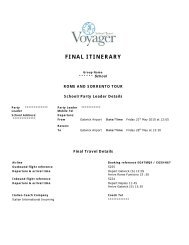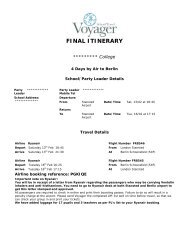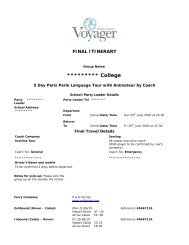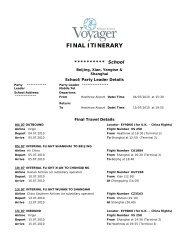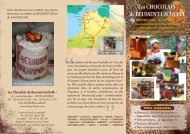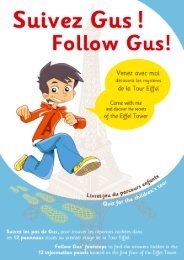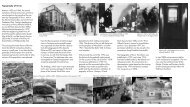The Vatican Museums â Highlight Tours - School Travel
The Vatican Museums â Highlight Tours - School Travel
The Vatican Museums â Highlight Tours - School Travel
You also want an ePaper? Increase the reach of your titles
YUMPU automatically turns print PDFs into web optimized ePapers that Google loves.
<strong>The</strong> <strong>Vatican</strong> <strong>Museums</strong> – <strong>Highlight</strong> <strong>Tours</strong><strong>The</strong> <strong>Vatican</strong> <strong>Museums</strong> house a huge number of exhibits and it is unlikely you will have time tosee everything. To help, we have suggested the following list which illustrates the ‘top 10’highlights the museums have to offer, together with where to find them and some history oneach one.We hope that this will help you to plan your visit.Sistine ChapelHanding over of the keys (Perugino)CONTURBATIO IESU CHRISTI LEGISLATORIS<strong>The</strong> fresco is one of the artistic peaks of the cycle of the Sistine Chapel and is consideredPerugino's masterpiece. <strong>The</strong> scene is dominated in the foreground by the episode of thehanding over to Peter, on his knees before Christ, of the "keys of the kingdom of heaven"(Matthew 16:13-20), a symbol of sovereignty and therefore of the conferring of power on the firstvicar of Christ on earth. In the background stands the Temple of Jerusalem, shown inRenaissance style as a domed octagonal construction flanked by two symmetrically placedtriumphal arches which are imitations of that of Constantine in Rome. Two other Gospelepisodes are shown in the background: the payment of the tribute (Matthew 17:24-27) and theattempted stoning of Christ (John 8:31-59; 10:31-39), to which the inscription above refers("CONTURBATIO IESU CHRISTI LEGISLATORIS"). <strong>The</strong> personage with the black beret andthick dark hair is usually recognized as being Perugino himself.
Creation of Adam (Michelangelo)"God created man in his own image, in the image of God he created him" (Genesis 1: 27).<strong>The</strong> focal point of the episode of the Creation of man is the contact between the fingers of theCreator and those of Adam, through which the breath of life is transmitted. God, supported byangels in flight and wrapped in a mantle, leans towards Adam, shown as a resting athlete,whose beauty seems to confirm the words of the Old Testament, according to which man wascreated to the image and likeness of God.<strong>The</strong> Last Judgement (Michelangelo)"If before the Last Judgment we are dazzled by splendour and fear, admiring on the one handthe glorified bodies and on the other those subjected to eternal damnation, we also understandthat the entire vision is deeply permeated by one light and one artistic logic: the light and logic ofthe faith that the Church proclaims by confessing: I believe in one God ... creator of heaven andearth, of all things visible and invisible" (from the Homily pronounced by the Holy Father JohnPaul II on 8 April 1994).<strong>The</strong> mighty composition, painted by Michelangelo between 1536 and 1541, is centred around thedominant figure of Christ, captured in the moment preceding that when the verdict of the LastJudgement is uttered (Matthew 25:31-46). His calm imperious gesture seems to both commandattention and placate the surrounding agitation. It starts a wide slow rotary movement in which all thefigures are involved. Excluded are the two upper lunettes with groups of angels bearing in flight thesymbols of the Passion (on the left the Cross, the nails and the crown of thorns; on the right thecolumn of the scourging, the stairs and the spear with the sponge soaked in vinegar). Next to Christis the Virgin, who turns her head in a gesture of resignation: in fact she can no longer intervene in
the decision, but only await the result of the Judgement. <strong>The</strong> Saints and the Elect, arranged aroundChrist and the Virgin, also anxiously await the verdict. Some of them can be easily recognized: StPeter with the two keys, St Laurence with the gridiron, St Bartholomew with his own skin which isusually recognized as being a self-portrait of Michelangelo, St Catherine of Alexandria with thecogwheel and St Sebastian kneeling holding the arrows. In the centre of the lower section are theangels of the Apocalypse who are wakening the dead to the sound of long trumpets. On the left therisen recover their bodies as they ascend towards heaven (Resurrection of the flesh), on the rightangels and devils fight over making the damned fall down to hell. Finally, at the bottom Charon withhis oars, together with his devils, makes the damned get out of his boat to lead them before theinfernal judge Minos, whose body is wrapped in the coils of the serpent. <strong>The</strong> reference in this part tothe Inferno of Dante Alighieri's Divina Commedia is clear. As well as praise, the Last Judgement alsocaused violent reactions among the contemporaries. For example the Master of Ceremonies Biagioda Cesena said that "it was most dishonest in such an honoured place to have painted so manynude figures who so dishonestly show their shame and that it was not a work for a Chapel of thePope but for stoves and taverns" (G. Vasari, Le Vite). <strong>The</strong> controversies, that continued for years,led in 1564 to the decision by the Congregation of the Council of Trent to have some of the figures ofthe Judgement that were considered "obscene" covered. <strong>The</strong> task of painting the covering drapery,the so-called "braghe" (pants) was given to Daniele da Volterra, since then known as the"braghettone". Daniele's "braghe" were only the first and in fact others were added in the followingcenturies.Raphael's Rooms<strong>School</strong> of Athens (Raphael)<strong>The</strong> most famous philosophers of ancient times move within an imposing Renaissancearchitecture which is inspired by Bramante's project for the renewal of the early ChristianBasilica of St Peter. Some of these are easily recognizable. In the centre Plato points upwardswith a finger and holds his book Timeus in his hand, flanked by Aristotle with Ethics;Pythagoras is shown in the foreground intent on explaining the diatesseron. Diogenes is lyingon the stairs with a dish, while the pessimist philosopher, Heracleitus, a portrait ofMichelangelo, is leaning against a block of marble, writing on a sheet of paper. Michelangelowas in those years executing the paintings in the nearby Sistine Chapel. On the right we seeEuclid, who is teaching geometry to his pupils, Zoroaster holding the heavenly sphere andPtolemy holding the earthly sphere. <strong>The</strong> personage on the extreme right with the black beret isa self-portrait of Raphael.
Liberation of St Peter (Raphael)<strong>The</strong> Liberation of St Peter shows the prince of the apostles and first Pope, miraculously savedfrom prison by an angel while the guards lie sleeping (Acts of the Apostles 12:5-12). <strong>The</strong> sceneis a reference to Julius II (pontiff from 1503 to 1513), who before being elected Pope was thetitular cardinal of St Peter in Chains. In the celebration of light Raphael confronts the divinelight of the angel with that of the dawn, of the moon, of the torches and of their reflections onthe armour and even of the natural light that enters from the window below, creating the mostextraordinary effects.Pinacoteca<strong>The</strong> Transfiguration (Raffaello Sanzio)Cardinal Giulio de' Medici (the future pope Clement VII) commissioned two paintings for thecathedral of S. Giusto of Narbonne, the city of which he had become bishop in 1515. <strong>The</strong>Transfiguration was entrusted to Raphael, and the Raising of Lazarus (now in the NationalGallery of London) to Sebastiano del Piombo. <strong>The</strong> Transfiguration was not sent to Francebecause after Raphael's death (1520), the cardinal kept it for himself, subsequently donating itto the church of S. Pietro in Montorio where it was placed over the high altar. In 1797, following
the Treaty of Tolentino, this work, like many others, was taken to Paris and returned in 1816,after the fall of Napoleon. It was then that it became part of the Pinacoteca of Pius VII (pontifffrom 1800 to 1823).<strong>The</strong> altarpiece illustrates two episodes narrated in succession in the Gospel according toMatthew: the Transfiguration above, with Christ in glory between the prophets Moses andElijah, and below, in the foreground, the meeting of the Apostles with the obsessed youth whowill be miraculously cured by Christ on his return from Mount Tabor.This is Raphael's last painting and appears as the spiritual testament of the artist. <strong>The</strong> work isconsidered in his biography, written by the famous artist and biographer of the 16th century,Giorgio Vasari, "the most famous, the most beautiful and most divine".Deposition from the Cross (Caravaggio)<strong>The</strong> Deposition, considered one of Caravaggio's greatest masterpieces, was commissionedby Girolamo Vittrice for his family chapel in S. Maria in Vallicella (Chiesa Nuova) in Rome. In1797 it was included in the group of works transferred to Paris in execution of the Treaty ofTolentino. After its return in 1817 it became part of Pius VII's Pinacoteca.Caravaggio did not really portray the Burial or the Deposition in the traditional way,inasmuch as Christ is not shown at the moment when he is laid in the tomb, but ratherwhen, in the presence of the holy women, he is laid by Nicodemus and John on theAnointing Stone, that is the stone with which the sepulchre will be closed. Around the bodyof Christ are the Virgin, Mary Magdalene, John, Nicodemus and Mary of Cleophas, whoraises her arms and eyes to heaven in a gesture of high dramatic tension.Caravaggio, who arrived in Rome towards 1592-93, was the protagonist of a real artisticrevolution as regards the way of treating subjects and the use of colour and light, and wascertainly the most important personage of the "realist" trend of seventeenth century painting.
Gregorian Egyptian MuseumAntinoo/OsirisStatue of the divinity Antinous/Osiris in white marble, signifying Upper Egypt. <strong>The</strong> statues of theSerapeum of the Canopus demonstrate how the emperor Hadrian had deified his favouriteAntinous, who drowned precisely in the canal called the Canopus which linked Alexandria to themain branch of the Nile, through his assimilation with Osiris, the god who dies and is reborn, in histurn already associated by the Ptolomies with Serapis, Alexandrian divinity of salvation.Gregorian Etruscan MuseumFibulaAmong the splendid gold ornaments that decorated the body of the deceased placed in the endcell, there is an enormous fibula (ancient version of the modern safety pin, used for holding anddecorating clothes) decorated with geometrical motifs, of plant and animal inspiration, executedwith various sophisticated techniques: granulation, embossing, punching. <strong>The</strong> small ducks in fullrelief on the arch are obtained by welding together the two halves obtained from an embossedsheet. <strong>The</strong> lions on the disk are also embossed and cut from another sheet.
Ethnological Missionary MuseumQuetzalcóatl, Pre-Colombian Mexican divinity<strong>The</strong> sculpture is a representation of Quetzalcóatl, a Nahvati name that indicates the FeatheredSerpent god and also the official title of the high priest. In the Aztec pantheon Quetzalcóatl,god of the day, creator of maize, of the religious ceremonies and lord of the priests, opposedthe destructive and nocturnal Tezcatlipoca, patron of warriors. This mythological reptile is thesymbol of one of the main and most complex divinities of Central America. According totradition, the emperor Montezuma II identified Cortés, the conqueror who had come by seafrom the east, with Quetzalcóatl who, according to a version of the Toltech myth of Ce Acatl,had gone away towards the east promising to return in a not specified future. This sculpture,from the high plain of Mexico, datable to the classical period of Aztec art, was given to PopePius XI by the Borgiano Museum of Propaganda Fide of Rome.
Opening HoursOpen Monday to Saturday: the Ticket Office is open from 9 am to 4 pm. <strong>The</strong> <strong>Museums</strong> close at6 pm.ClosedSunday (except the last Sunday of every month, free entrance from 9 am to 12.30 pm; the<strong>Museums</strong> close at 2 pm unless it coincides with Easter Sunday, the 29 th of June (St. Peter andPaul), 25 th and 26 th of December (Christmas and St. Stephen). Free entrance also the 27 th ofSeptember (World day of Tourism)January 1, 6February 11March 19April 24 (Easter), 25 (Easter Monday)May 1June 29 (St. Peter and Paul)August 14, 15November 1December 8 (Immaculate Conception), 25, 26Admission<strong>The</strong> Admission Ticket permits the tourist to visit the <strong>Vatican</strong> <strong>Museums</strong> and the Sistine Chapeland is valid for the day of issue.Tickets are not refundable. Some sections of the <strong>Vatican</strong> <strong>Museums</strong> usually closed to the publiccan be visited on request.Full Price - € 15,00



